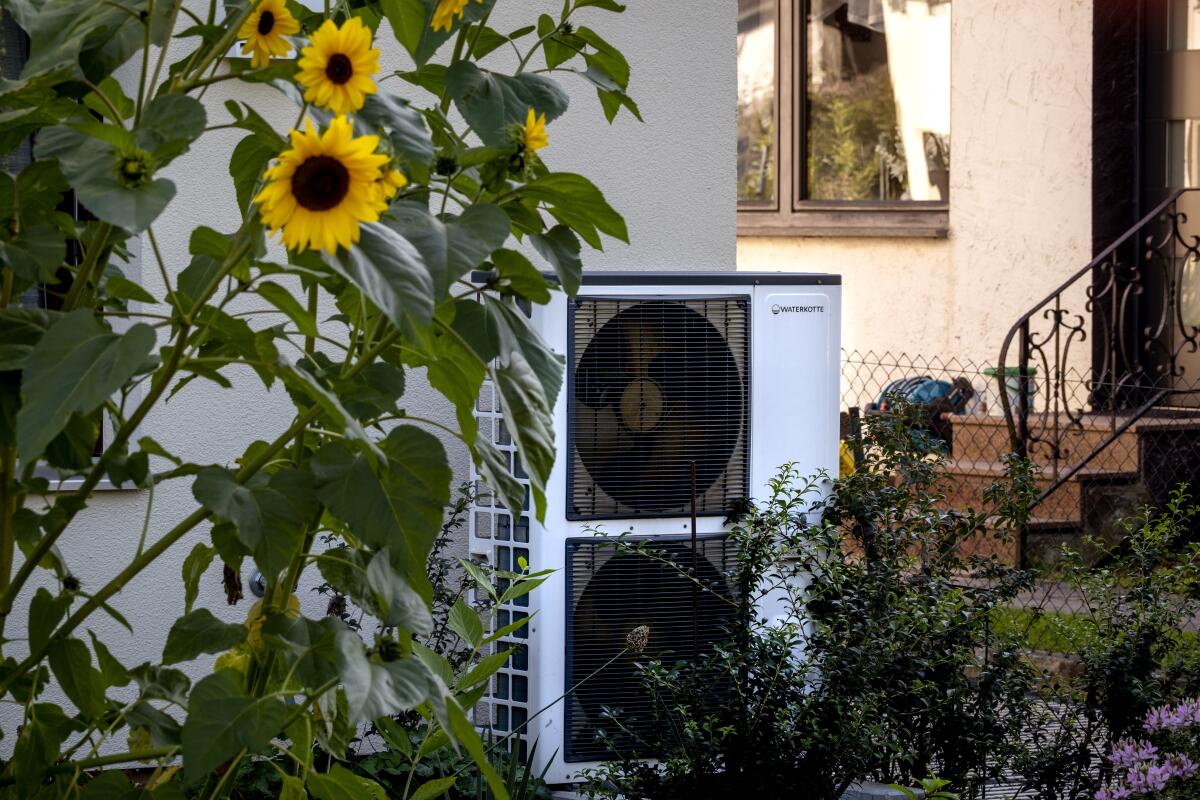Opinion: Heat pumps cut costs and pollution. So why isn’t it easier to install one in California?

- Share via
The nation’s electric utilities have voiced overwhelming support for reducing carbon emissions. Eighty percent of U.S. electricity customers are served by a utility with a 100% carbon-reduction target, according to the Smart Electric Power Alliance, and utility executives have touted their sustainability plans at the U.N. Climate Conference, Davos and beyond.
So why is it so hard to get help switching to a climate-friendly heat pump?
Marvels of modern engineering, heat pumps provide heating and cooling by transferring warm or cold air into or out of a home, eliminating the need to generate heat. They have been shown to substantially slash consumer heating costs and cut greenhouse gas emissions up to 50%.
Some of the world’s most populous places, including parts of India, Pakistan and the Middle East, face extended intolerable conditions.
Like so many other Americans who helped fuel a residential construction boom following the onset of the pandemic, I recently embarked on a wholesale remodel of my home in the Bay Area. Unlike most of my fellow remodelers, I make my living analyzing trends in customer experience with the nation’s electric, gas and water utilities. As an energy nerd, I saw the project as a chance to delve into the various incentives that the utilities have been promoting to facilitate my conversion from a gas-fired furnace to an electric heat pump.
What I found was a tangle of red tape, well-meaning but tragically ill-informed customer service representatives, and hours upon hours of filing forms, chasing down obscure information and questioning contractors — all in a quixotic quest to claim my local, state and federal rebates.
Heat pumps loom large as a component of electric utility sustainability initiatives. The Biden administration recently announced that $63 million in Inflation Reduction Act funding would be used to spur domestic manufacturing of heat pumps, and local, state and federal incentives have been deployed in most jurisdictions nationwide to encourage consumers to make the switch.
When the last ice age ended thousands of years ago, the rate of global warming — which was roughly 10 times slower than what we see today — was rapid enough to wipe out entire species.
At the federal level, consumers are eligible for a tax credit that covers 30% of the cost of buying and installing a heat pump, up to a maximum of $2,000 per year. The TECH Clean California program offers incentives to contractors to install heat pumps, and the Los Angeles Department of Water & Power and other utilities offer rebates and other benefits. In Marin County, where I live, state, county and local incentives promised to bring the total rebate on my project to almost $5,000.
That prospect, along with the long-term value of increased efficiency, was enough to persuade me to take the plunge on a system that was a bit more expensive than a comparable gas furnace. Moreover, my extensive research on the subject was enough to overcome widespread misconceptions about the technology and its ability to comfortably heat and cool my home.
The good news is that my heat pump works wonderfully! It’s so good that I’ve started recommending one to my friends and neighbors. It isn’t loud or dry like traditional heat; it’s even and smooth. The system allowed much more flexibility in our construction and design. And, best of all, I now have central cooling for the first time.
Unfortunately, I’ve also put hours of work into chasing rebates I still haven’t received.
Ironically, the easiest part of the process was applying for a federal rebate through the Internal Revenue Service. When the IRS sets the benchmark for customer service, you know you have a problem.
Among the challenges I faced were an hour-plus conversation with a friendly Pacific Gas & Electric Co. representative who knew absolutely nothing about heat pump programs; an apologetic county official who informed me that I would need to fill out a commercial form even though my project was residential because “that’s the way the paperwork is written”; and even a request to provide detailed photos of my old gas furnace — the one that had already been removed — to prove I had made the switch.
Fortunately, because I was documenting the process partly for my own education, I had those photos and welcomed the opportunity to find all the hurdles consumers face. But will typical consumers — those who don’t spend their workdays analyzing the minutiae of utility customer experience — even bother to deal with this craziness? Probably not.
Perhaps that has something to do with the widespread customer apathy toward electric utility sustainability efforts. J.D. Power’s most recent study of this topic found that just 19% of customers were even aware of their utility’s carbon reduction initiatives.
We’re living in an era of amazing technological innovation, and we have public policies designed to catalyze consumer adoption of these breakthroughs. But if the same old bureaucratic hurdles stand in the way of access to those programs, no one wins.
There is a huge opportunity here for innovative utilities to take the lead on improving not only our policies but also the mechanisms that make them work. As a utilities industry professional, I’m optimistic that our leaders will take up this cause. As a consumer, I just hope I eventually get my rebate.
Andrew Heath is the vice president of utilities intelligence at J.D. Power.
More to Read
A cure for the common opinion
Get thought-provoking perspectives with our weekly newsletter.
You may occasionally receive promotional content from the Los Angeles Times.












